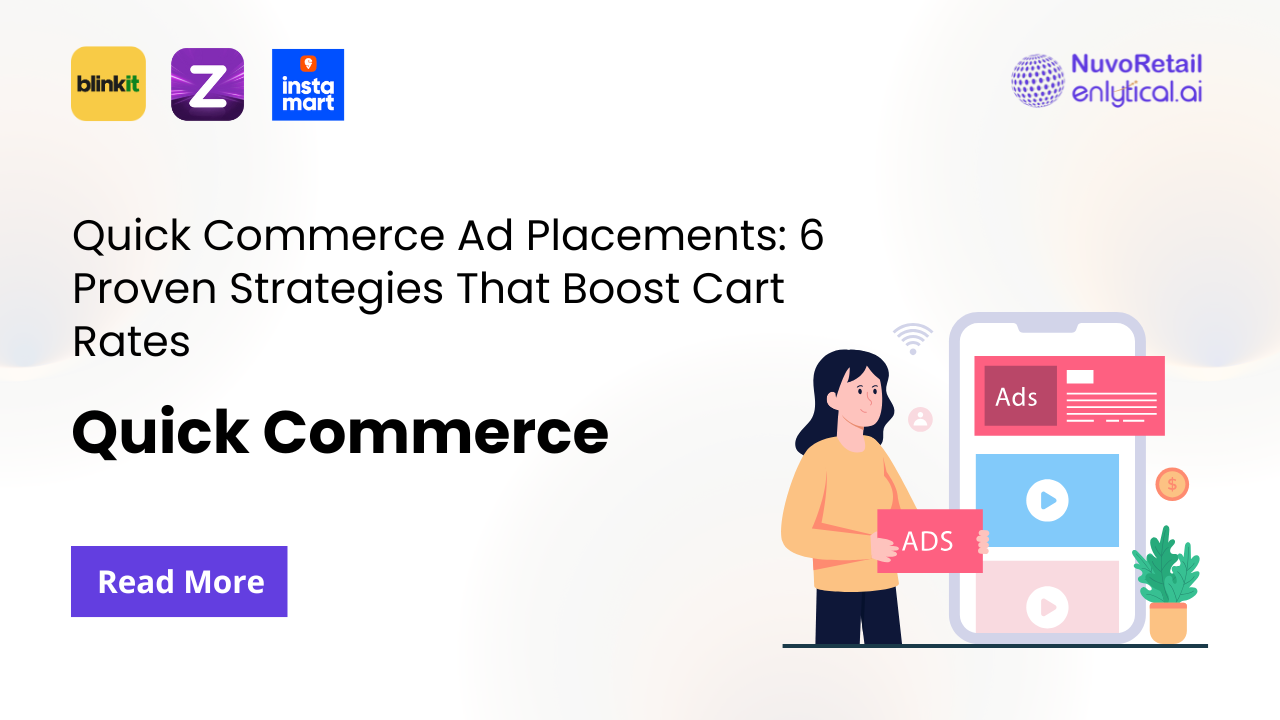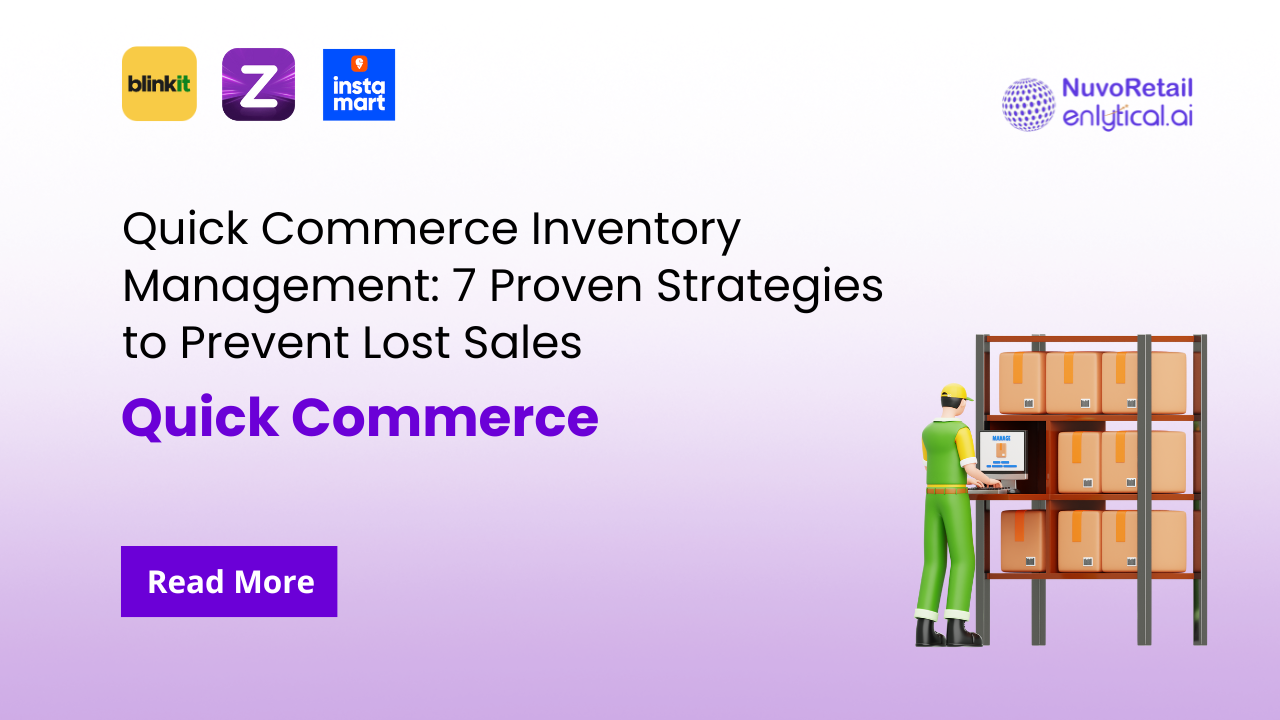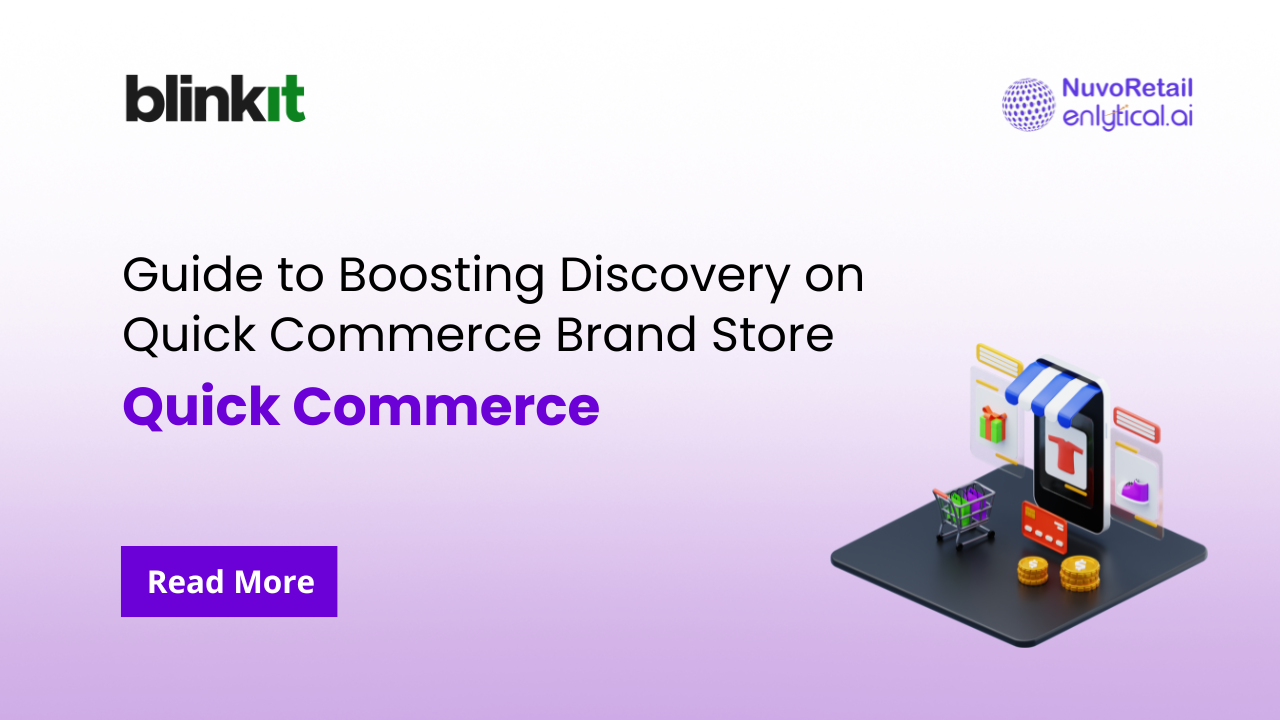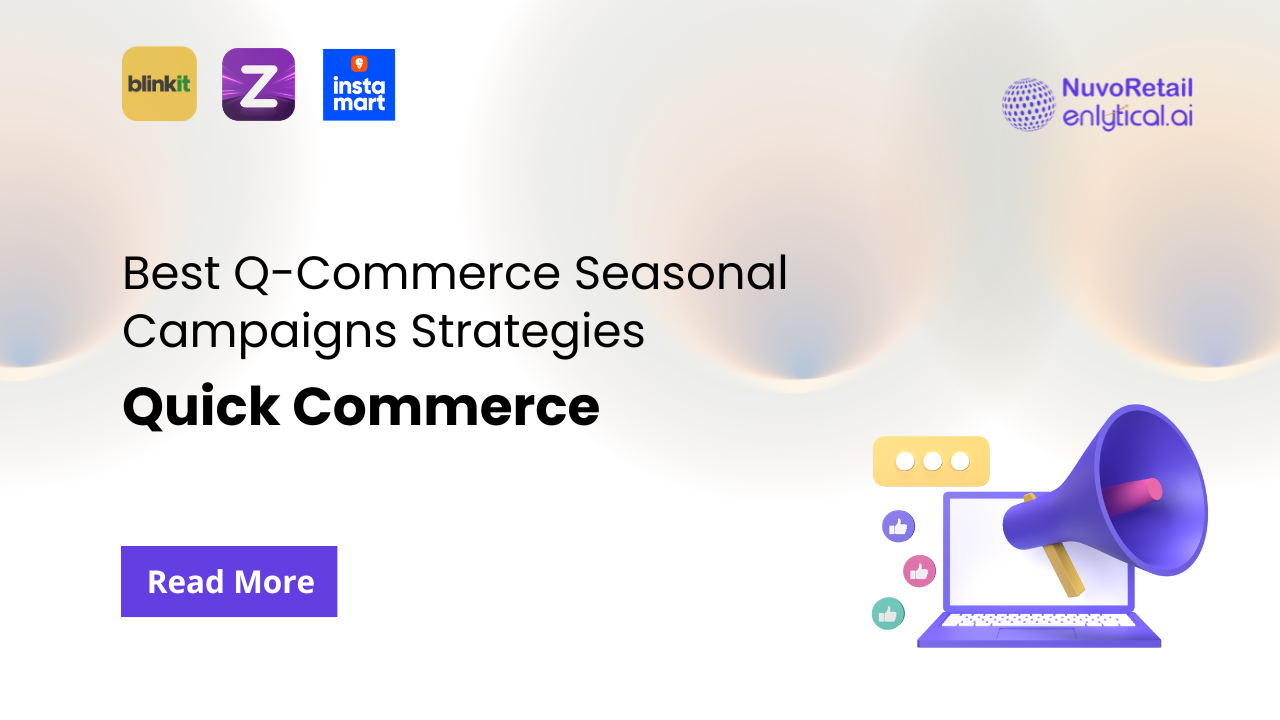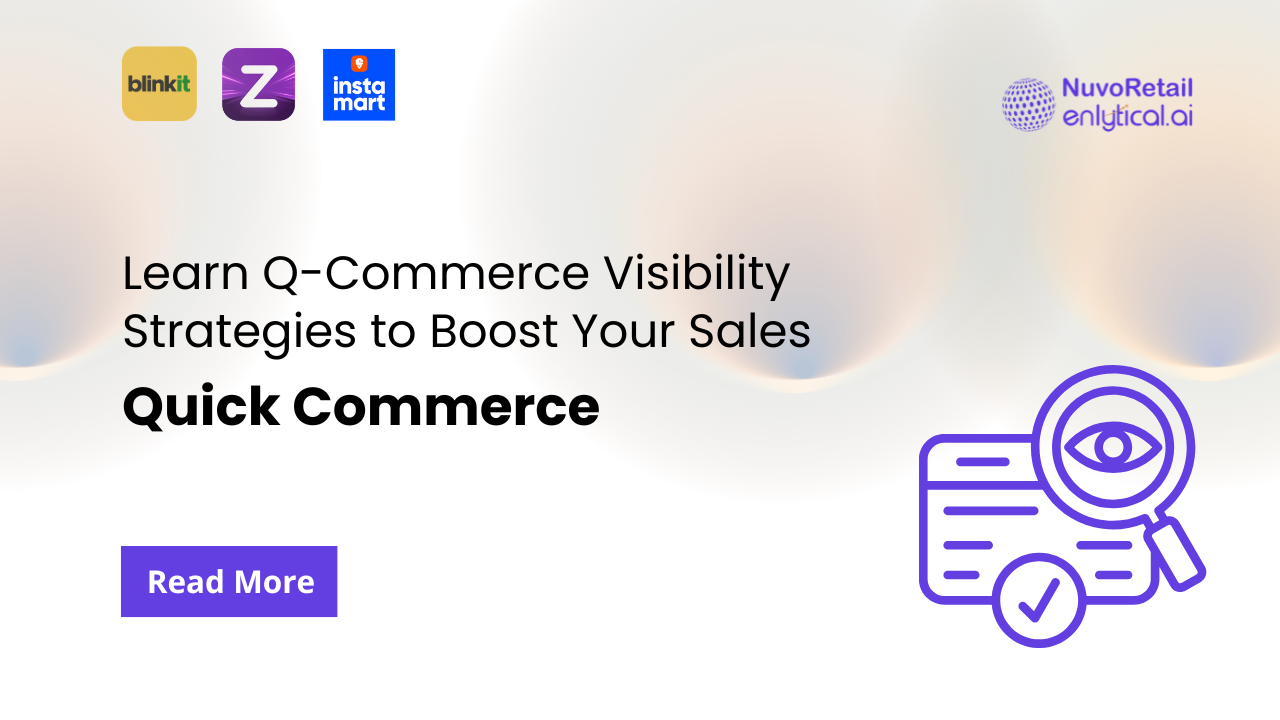Quick commerce ad placements have revolutionized how brands drive conversions on rapid delivery platforms. As consumers increasingly rely on 10-15 minute delivery services like Blinkit, Zepto, and Swiggy Instamart, understanding strategic ad positioning becomes critical for maximizing revenue.
The q commerce landscape has evolved dramatically, with advertising costs rising significantly as platforms recognize the value of premium placements. Brands investing in quick commerce advertising are seeing remarkable returns when they understand where, when, and how to position their products for maximum visibility and conversion. Businesses that work with quick commerce marketing specialists like NuvoRetail can navigate these economics better, ensuring their quick commerce ad placements are data-driven rather than guesswork.
Table of Contents
- Understanding Quick Commerce Ad Placement Economics
- The 7 Most Effective Ad Placement Zones
- How Blinkit, Zepto & Instamart Structure Their Ad Inventory
- Data-Driven Placement Optimization Strategies
- Timing & Context: When Placements Matter Most
- Measuring ROI on Quick Commerce Platforms
- Future Trends in Quick Commerce Marketing
Understanding Quick Commerce Ad Placement Economics
Quick commerce ad placements have become increasingly competitive and expensive. According to Exchange4Media, CPMs have doubled on quick commerce platforms during peak seasons, reflecting the immense value these placements deliver.
The rapid delivery services market operates on a fundamentally different model than traditional e-commerce. With consumers making impulse purchases within seconds, the right ad placement can mean the difference between a scroll-past and an immediate add-to-cart action.
Key economic factors influencing placement costs:
- Time of day premium pricing during evening hours
- Category-based competition levels
- Seasonal demand fluctuations
- User segment targeting premiums
- Placement zone hierarchy
Quick commerce platforms like Zepto and Swiggy Instamart use sophisticated algorithms to price their ad inventory based on predicted conversion potential, making strategic placement selection crucial for ROI optimization.
The 6 Most Effective Quick Commerce Ad Placement Zones
In today’s rapidly evolving e-commerce landscape, quick commerce ad placements have become a crucial driver of conversion and sales for brands on rapid delivery platforms. These placements allow advertisers to capture consumers’ attention at moments of high intent, creating opportunities for both immediate sales and long-term engagement. Understanding the best-performing ad zones can significantly enhance campaign performance. Here are the six most effective quick commerce ad placements zones that brands should leverage:
1. Homepage Hero Banners
The homepage hero banner is the most coveted real estate in quick commerce ad placements. Appearing immediately upon app launch, these banners capture users when they are most attentive and ready to explore products. Conversion rates for homepage hero banners are typically 3-4x higher than mid-page placements, making them ideal for promoting high-margin products, new launches, or limited-time offers.
Brands that optimize homepage hero banners strategically using compelling visuals, concise messaging, and clear call-to-actions see measurable boosts in both click-through rates and purchases. Platforms like NuvoRetail specialize in helping businesses maximize the impact of these premium quick commerce ad placements.
2. Category Page Sponsored Listings
Category page sponsored listings are a highly effective placement for brands targeting active shoppers. When a user navigates to a specific product category, such as “Cold Drinks” or “Snacks,” they have already demonstrated clear purchase intent. Securing a top spot in these listings ensures your product is seen at the most relevant moment, increasing the likelihood of conversion.
For example, a beverage brand appearing at the top of the “Cold Drinks” category captures motivated buyers exactly when they are deciding what to purchase. Leveraging quick commerce ad placements in category pages ensures relevance and maximizes the probability of driving an immediate sale.
3. Search Result Sponsored Products
Search-driven quick commerce ad placements target users actively seeking specific products, making them some of the most high-intent positions available. Whether a user searches for “chips” or “chocolate,” sponsored results appear at the top of the search feed, directly in front of buyers ready to act.
These placements are especially effective for time-sensitive promotions or new product launches, as they capture users at the precise moment of consideration. Brands focusing on search result placements often see significant improvements in add-to-cart rates due to the highly targeted nature of these ads.
4. Cart Page Cross-Sell Placements
Cart page cross-sell placements are an underutilized but powerful zone for quick commerce ad placements. Once a customer has added items to their cart, they are already committed to purchase. Introducing complementary products or suggesting upgrades at this stage can significantly boost average order value.
For instance, a user purchasing pasta might be presented with a discount on pasta sauce. Properly executed cart page quick commerce ad placements not only enhance revenue per transaction but also improve the customer shopping experience by offering relevant product suggestions.
5. Checkout Abandonment Pop-Ups
Checkout abandonment pop-ups are strategically designed quick commerce ad placements that help recover potentially lost sales. These pop-ups can offer limited-time discounts, free delivery thresholds, or complementary product recommendations to incentivize the user to complete their purchase.
Brands that integrate checkout pop-ups into their quick commerce ad placements strategy often see measurable reductions in cart abandonment rates, turning near-misses into successful conversions.
6. Post-Order Confirmation Screens
Many advertisers overlook post-purchase placements, yet they are a valuable zone for quick commerce ad placements. Users on confirmation screens have already made a purchase, creating an opportunity to drive repeat orders or cross-sell relevant products for future transactions.
By introducing promotions or personalized suggestions at this stage, brands can capitalize on the positive sentiment immediately following a purchase, building loyalty and encouraging next-order planning.
Integrating Quick Commerce Ad Placements Strategically
While each quick commerce ad placement zone offers unique advantages, the most successful campaigns combine multiple placements to achieve holistic impact. Homepage banners drive awareness, search results capture high-intent buyers, and cart or post-purchase placements increase order value and loyalty.
Brands that diversify their quick commerce ad placements across these touchpoints consistently outperform those relying on a single placement, achieving stronger performance, higher revenue, and improved customer engagement.
How Blinkit, Zepto & Instamart Structure Their Ad Inventory
The leading rapid delivery platforms Blinkit, Zepto, and Swiggy Instamart have developed highly sophisticated advertising ecosystems. Economic Times reports that quick commerce app designs have evolved significantly, incorporating pop-ups, ads, banners, and even gamification elements to maximize engagement while maintaining user experience. These innovations aim to maximize user engagement while maintaining a smooth, frictionless shopping experience. For brands looking to leverage rapid delivery platforms, understanding the nuances of quick commerce ad placements on each platform is essential.
Blinkit’s Advertising Approach
Blinkit has built its advertising strategy around visual storytelling and lifestyle integration. Large-format banners on the homepage and category sponsorships are a key component of their quick commerce ad placements, capturing users’ attention during high-intent moments.
What makes Blinkit’s approach unique is how seamlessly ads are embedded into the shopping experience. Instead of interrupting the user journey, the ads feel like a natural extension of browsing, often highlighting lifestyle-oriented use cases such as pairing snacks with beverages or showcasing meal bundles. Brands that leverage Blinkit’s quick commerce ad placements effectively focus on creating visually compelling content that resonates with users instantly, encouraging both discovery and purchase.
Zepto’s Placement Philosophy
Zepto, with its ultra-fast 10–15 minute delivery promise, designs quick commerce ad placements that align perfectly with its speed-first brand promise. Ads on Zepto emphasize clarity, minimal friction, and instant recognition, ensuring users can act with a single tap.
Top-performing placements on Zepto include search result sponsorships, category page banners, and cart page cross-sells. These placements are strategically timed and positioned to capture users when they are most likely to convert. By emphasizing speed and convenience, Zepto’s quick commerce ad placements not only increase conversions but also reinforce the platform’s promise of instant gratification.
Swiggy Instamart’s Integrated Model
Swiggy Instamart takes a unique approach by leveraging its broader food delivery ecosystem. Its quick commerce ad placements often blend grocery and meal planning, creating cross-promotional opportunities that few competitors can match. For example, a user ordering dinner via Swiggy might see grocery suggestions for complementary ingredients, seamlessly connecting meal planning with grocery shopping.
Instamart utilizes homepage banners, push notifications, and post-order placements to maximize visibility and engagement. By integrating advertising across Swiggy’s services, brands can tap into a wider, highly engaged user base. This cross-platform approach makes quick commerce ad placements on Instamart particularly effective for driving repeat purchases and boosting average order value.
Tailoring Quick Commerce Ad Placements for Platform-Specific Success
Understanding the differences between Blinkit, Zepto, and Instamart enables brands to optimize their quick commerce ad placements for platform-specific performance. Blinkit rewards visually appealing, lifestyle-focused ads; Zepto thrives on speed-first, frictionless placements; and Instamart excels at cross-promotional strategies that integrate grocery and meal delivery.
Brands that diversify their quick commerce ad placements across these platforms, while tailoring content to each platform’s strengths, consistently see higher engagement, stronger conversion rates, and improved customer retention.
Data-Driven Placement Optimization Strategies
Strategic quick commerce ad placements require continuous optimization based on performance data. According to Exchange4Media, q-commerce advertising has climbed 50% in just one year, reflecting both increased competition and proven effectiveness.
Key optimization metrics to track:
- Click-through rate (CTR) by placement zone
- Conversion rate
- CPM across different placements
- Repeat purchase rate from placed ads
Successful brands on rapid delivery platforms conduct A/B testing across multiple placement combinations, adjusting bids and creative elements based on performance data.
Advanced optimization techniques:
Dynamic creative optimization allows brands to test multiple ad variations simultaneously across different quick commerce platforms. Products that perform well in hero positions might underperform in search placements, requiring tailored creative approaches.
Inventory optimization strategies also play a crucial role in ad placement effectiveness – there’s no value in driving clicks to out-of-stock items.
Timing & Context: When Placements Matter Most
Quick commerce marketing success depends heavily on temporal and contextual factors. The same ad placement can deliver vastly different results based on when it appears and what context surrounds it.
Peak conversion windows:
- Morning rush hours: Breakfast items, beverages
- Lunch hours: Snacks, quick meals
- Evening prime time: Dinner ingredients, family packs
- Late night: Indulgence items, cravings
Hyperlocal targeting strategies enable brands to adjust placements based on neighborhood preferences, weather conditions, and local events.
Weather-responsive placements demonstrate exceptional performance. Ice cream ads during heat waves, hot beverage placements during cold snaps, and umbrella promotions during rain forecasts capitalize on immediate contextual needs.
Event-based timing also drives significant uplift. Sporting events, festivals, and holidays create predictable demand patterns that strategic advertisers exploit through timed placement boosts.
Measuring ROI on Quick Commerce Platforms
Understanding true return on investment for quick commerce ad placements requires looking beyond simple click metrics to business outcomes.
Comprehensive ROI framework:
Calculate total advertising spend across all placement types, then measure against incremental revenue generated. However, quick commerce platforms present unique measurement challenges due to their speed and impulse-driven nature.
Attribution becomes complex when users see multiple placements in a single session. A homepage banner might create awareness, while a search placement captures the final conversion – both deserve credit in sophisticated attribution models.
Key ROI indicators:
- Revenue per ad rupee spent
- Incremental sales lift versus organic performance
- Brand awareness impact on future organic searches
Platforms like Nuvo Retail’s quick commerce solutions provide analytics frameworks specifically designed for rapid delivery service measurement.
Flash sales and dynamic bundling strategies combined with strategic placements can amplify ROI significantly, creating urgency that drives immediate conversions.
Future Trends in Quick Commerce Marketing
The evolution of quick commerce advertising continues accelerating, with several emerging trends reshaping placement strategies:
AI-Powered Dynamic Placements:
Machine learning algorithms increasingly determine optimal placement allocation in real-time, adjusting bids and positions based on predicted individual user conversion probability.
Augmented Reality Integration:
AR try-before-you-buy features within ad placements will become standard, particularly for fashion, cosmetics, and home goods categories.
Voice-Activated Ad Interactions:
As voice commerce grows, quick commerce platforms will integrate voice-responsive ad placements that enable hands-free ordering.
Hyper-Personalized Placement Streams:
Rather than standardized placement zones, each user may soon see completely personalized ad streams based on purchase history, preferences, and predictive intent modeling.
The rapid delivery ecosystem continues evolving at remarkable speed. Brands that stay ahead of placement innovations while maintaining data-driven optimization will capture disproportionate market share.
Conclusion
Quick commerce ad placements represent one of the most powerful conversion drivers in modern digital marketing. As Blinkit, Zepto, Swiggy Instamart, and other rapid delivery services continue growing, understanding strategic placement optimization becomes increasingly critical for brand success.
The six placement zones outlined – homepage heroes, category sponsorships, search results, cart cross-sells, checkout interventions, and post-purchase screens – each offer unique advantages when leveraged strategically. Combined with data-driven optimization, contextual timing, and platform-specific customization, these quick commerce advertising approaches deliver measurable improvements.
As the q commerce landscape becomes more competitive and sophisticated, brands must evolve their placement strategies continuously, testing new positions, measuring performance rigorously, and adapting to emerging consumer behaviors in the 10-15 minute delivery economy.
Ready to Optimize Your Quick Commerce Ad Strategy?
Transform your rapid delivery platform performance with expert guidance. Contact Nuvo Retail today to develop a customized quick commerce marketing strategy that maximizes your ad placement ROI and drives sustainable growth across Blinkit, Zepto, Instamart, and other leading platforms.
Start optimizing your placements now and capture the explosive growth opportunity in India’s quick commerce revolution.
